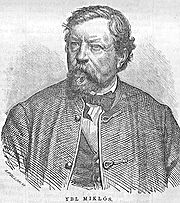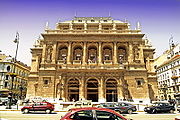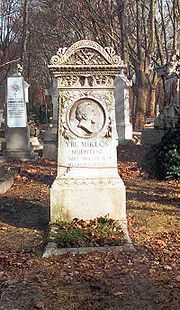
Miklós Ybl
Encyclopedia

Europe
Europe is, by convention, one of the world's seven continents. Comprising the westernmost peninsula of Eurasia, Europe is generally 'divided' from Asia to its east by the watershed divides of the Ural and Caucasus Mountains, the Ural River, the Caspian and Black Seas, and the waterways connecting...
's leading architect
Architect
An architect is a person trained in the planning, design and oversight of the construction of buildings. To practice architecture means to offer or render services in connection with the design and construction of a building, or group of buildings and the space within the site surrounding the...
s in the mid to late nineteenth century as well as Hungary
Hungary
Hungary , officially the Republic of Hungary , is a landlocked country in Central Europe. It is situated in the Carpathian Basin and is bordered by Slovakia to the north, Ukraine and Romania to the east, Serbia and Croatia to the south, Slovenia to the southwest and Austria to the west. The...
's most influential architect during his career. His most well-known work is the Hungarian State Opera House
Hungarian State Opera House
The Hungarian State Opera House is a neo-Renaissance opera house located in central Budapest, on Andrássy út. It is home to the Budapest Opera Ball, a society event dating back to 1886.-History:...
in Budapest
Budapest
Budapest is the capital of Hungary. As the largest city of Hungary, it is the country's principal political, cultural, commercial, industrial, and transportation centre. In 2011, Budapest had 1,733,685 inhabitants, down from its 1989 peak of 2,113,645 due to suburbanization. The Budapest Commuter...
(1875-84).
After graduating from the Institute of Technology (the Politechnikum) in Vienna
Vienna
Vienna is the capital and largest city of the Republic of Austria and one of the nine states of Austria. Vienna is Austria's primary city, with a population of about 1.723 million , and is by far the largest city in Austria, as well as its cultural, economic, and political centre...
, Ybl became Mihály Pollack's assistant in 1832 and worked in Henrik Koth's office between 1836 and 1840. Following this, he moved to Munich
Munich
Munich The city's motto is "" . Before 2006, it was "Weltstadt mit Herz" . Its native name, , is derived from the Old High German Munichen, meaning "by the monks' place". The city's name derives from the monks of the Benedictine order who founded the city; hence the monk depicted on the city's coat...
and then to Italy
Italy
Italy , officially the Italian Republic languages]] under the European Charter for Regional or Minority Languages. In each of these, Italy's official name is as follows:;;;;;;;;), is a unitary parliamentary republic in South-Central Europe. To the north it borders France, Switzerland, Austria and...
to study. After his return, he entered into partnership with the son of Mihály Pollack, Ágoston; together they refurbished the Ikervár castle of Count Lajos Batthyány
Lajos Batthyány
Count Lajos Batthyány de Németújvár was the first Prime Minister of Hungary. He was born in Pressburg on 10 February 1807, and was executed by firing squad in Pest on 6 October 1849, the same day as the 13 Martyrs of Arad.-Career:His father was Count József Sándor Batthyány , his mother Borbála...
. His first main work was the church in Fót, built between 1845 and 1855.
His early, large projects were built in Romantic style, influenced by eastern motifs. Although Romanesque
Romanesque architecture
Romanesque architecture is an architectural style of Medieval Europe characterised by semi-circular arches. There is no consensus for the beginning date of the Romanesque architecture, with proposals ranging from the 6th to the 10th century. It developed in the 12th century into the Gothic style,...
shapes also occur in his later buildings, after his second study tour to Italy from 1860 he became interested in the possibility of the revitalisation of the Italian Renaissance
Italian Renaissance
The Italian Renaissance began the opening phase of the Renaissance, a period of great cultural change and achievement in Europe that spanned the period from the end of the 13th century to about 1600, marking the transition between Medieval and Early Modern Europe...
style, and designed several neo-Renaissance
Neo-Renaissance
Renaissance Revival is an all-encompassing designation that covers many 19th century architectural revival styles which were neither Grecian nor Gothic but which instead drew inspiration from a wide range of classicizing Italian modes...
buildings. Many of his buildings became, and indeed are still today, determinant elements of the cityscape of Budapest
Budapest
Budapest is the capital of Hungary. As the largest city of Hungary, it is the country's principal political, cultural, commercial, industrial, and transportation centre. In 2011, Budapest had 1,733,685 inhabitants, down from its 1989 peak of 2,113,645 due to suburbanization. The Budapest Commuter...
: Saint Stephen's Basilica
Saint Stephen's Basilica
St. Stephen's Basilica is a Roman Catholic basilica in Budapest, Hungary. It is named in honour of Stephen, the first King of Hungary , whose mummified fist is housed in the reliquary.-Architecture:...
(1867-91), the Rác Baths, the former Palace of Customs, (1871-74), and the throne room and Krisztinaváros wing of the Royal Palace
Buda Castle
Buda Castle is the historical castle and palace complex of the Hungarian kings in Budapest, first completed in 1265. In the past, it was also called Royal Palace and Royal Castle ....
. He also built countless churches, apartments and castles in the provinces.
The annual architectural prize founded in 1953 was named after him in his honor.
Major works


- 1845-1849. FótFótFót is a town in Pest county, Budapest metropolitan area, Hungary.-Location:Fót is about north of the edge of Budapest. The North Hungarian foothills lie to the west. The nearest settlement to the west is Dunakeszi, to the northeast are Csomád and Veresegyház, to the east is Mogyoród and Budapest...
, Károlyi castle rebuilding - 1845-1855. Fót, Roman Catholic church
- cc. 1852. BudapestBudapestBudapest is the capital of Hungary. As the largest city of Hungary, it is the country's principal political, cultural, commercial, industrial, and transportation centre. In 2011, Budapest had 1,733,685 inhabitants, down from its 1989 peak of 2,113,645 due to suburbanization. The Budapest Commuter...
, Grabovszky – (Rózsa-) villa - 1857-58. Budapest, National stables
- cc. 1860. AlbertirsaAlbertirsaAlbertirsa is a town in Ceglédi kistérség, Pest megye, and the middle of the Great Hungarian Plain. Although it has got its town status in 2003, still has its village-scent that is so common for most of the inhabitations in the region.- History :Initially Albertirsa was two separate inhabitations:...
, Szapáry chapel crypt - cc. 1860. LeányfaluLeányfaluLeányfalu is a riverside village in Pest county, Budapest metropolitan area, Hungary. It is just north of Szentendre located at . Located between the branch of the Small Danube and the spurs of the Visegrád Hills, Leányfalu stretches some 5 kilometres in length...
, Gyulai-villa - cc. 1860. Gerla, Wenckheim castle
- 1860-1864. NagycenkNagycenkNagycenk is a village in Győr-Moson-Sopron county, Hungary.- External links :*...
, R.C. church - 1862-től. KecskemétKecskemétKecskemét is a city in the central part of Hungary. It is the 8th largest city of the country, and the county seat of Bács-Kiskun.Kecskemét lies halfway between the capital Budapest and the country's third-largest city, Szeged, 86 kilometres from both of them and almost equal distance from the two...
, Evangelical church - 1862-1865. Budapest, Festetics palace
- 1863. Budapest, German theatre (not built)
- 1863-tól. Budapest, Károly palace
- 1863-1864. Budapest, MTA building
- cc. 1865. FegyvernekFegyvernekFegyvernek is a village in Jász-Nagykun-Szolnok county, in the Northern Great Plain region of central Hungary.-Geography:It covers an area of and has a population of 7087 people ....
, Szapáry castle - 1865-1866. Budapest, old parliament building
- 1865-1879. Budapest, R.C. church, Bakáts squ.
- 1867. Budapest, Pálffy palace
- 1867-1891. Budapest, Szent István basilica. Began by Hild, continued by Ybl and finished by J. Kauser.
- 1870-1874. Budapest, Customs house
- 1871. Budapest, Margit bridge (not built)
- cc. 1872. ParádParádParád is a village in Heves County, Hungary, north of the Mátra, in the valley of the Parádi-Tarna.Parád is noted for the numerous mineral springs in its area, and the famous spa in Parádfürdő....
, Ybl Hotel - 1873-1884. Budapest, Opera house
- 1874-1982. Budapest, Castle kiosk and bazaar
- 1875-1879. Ókígyós, Wenckheim castle
- 1880-1882. Parádsasvár, Károlyi castle
- 1880-1891. Budapest, Castle hill remodelling
- 1882-1888. Budapest, Budapest Clarisseum R.C. church
- 1883-1884. Budapest, Széchenyi palace (demolished)
- cc. 1888. Parád, Erzsébet Hotel
- and other structures in CsurgóCsurgóCsurgó is a town in Somogy county, Hungary. It is located at around .- Sightseeings :The town was important educational center of the Reformed Church in Hungary. Its Reformed Church College was visited by Mihály Csokonai Vitéz, the famous poet, too.The Árpád age church has characteristic...
, DobozDobozDoboz is a village in Békés County, in the Southern Great Plain region of south-east Hungary.-Geography:It covers an area of 54.47 km² and has a population of 4563 people ....
, KétegyházaKétegyházaKétegyháza or Chitigaz , its name meaning in Hungarian Two Churches) is a large village in Békés County, in the Southern Great Plain region of south-east Hungary...
, LengyeltótiLengyeltóti-Settings:The town can be found south from Fonyód, along the highway to Somogyvár, the old seat of the county. The highway went from the Lake Balaton to the southern part of the vountry. The town sits on the top of a hill. Its name: Tóti, meant slavonic people in the ancient times, so probably the...
, Mácsa, MarcaliMarcaliMarcali is a town in Somogy county, Hungary.- External links :* *...
, Ókigyós, SurányŠuranyŠurany is a town and a railroad hub in the Nové Zámky District, Nitra Region, southern Slovakia.Alongside the main settlement, it has the boroughs of Kostolný Sek and Nitriansky Hrádok, both annexed 1976....
, etc.

